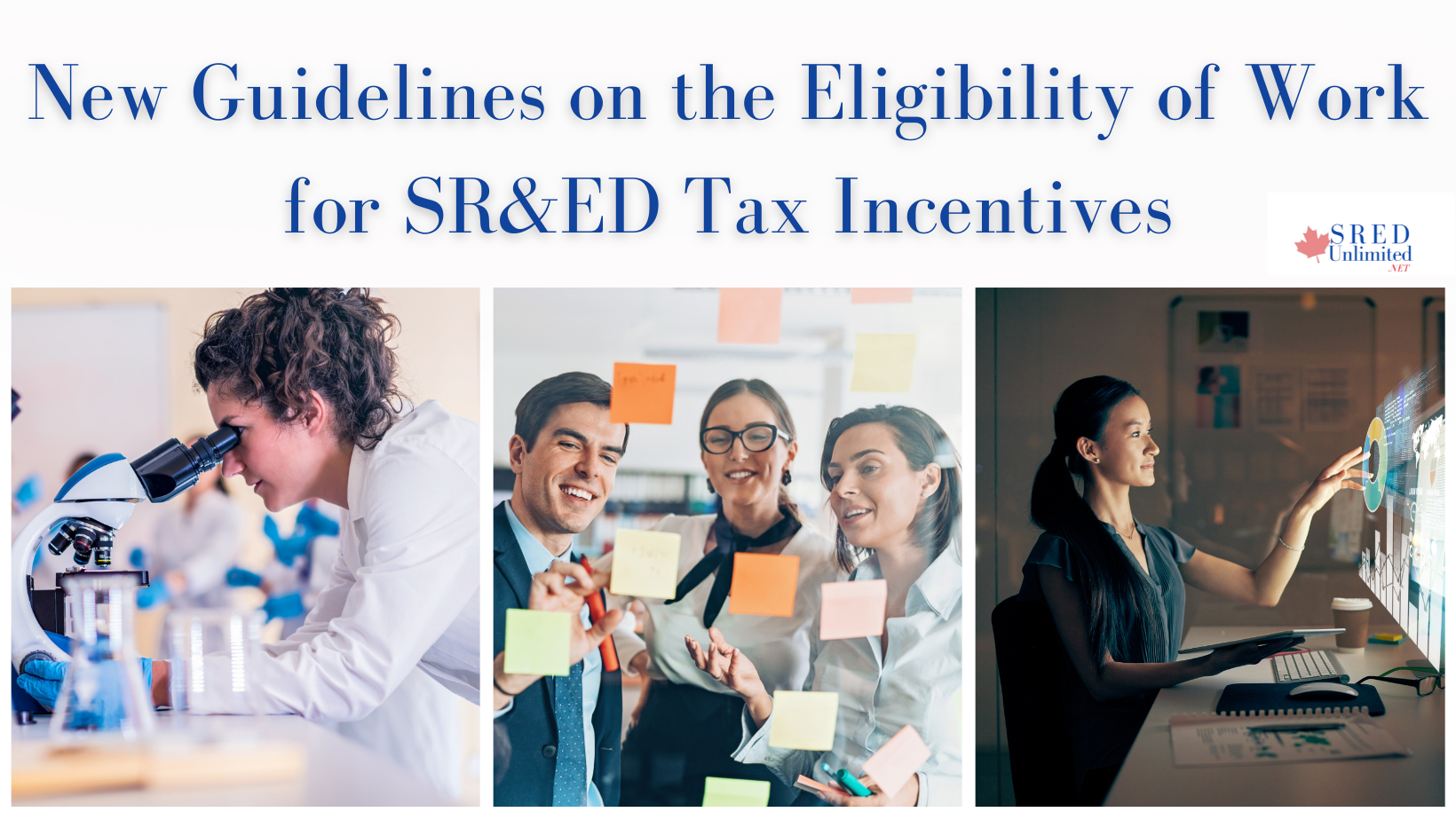The Canada Revenue Agency (CRA) recently replaced the wording of its Eligibility of Work for SR&ED Investment Tax Credits Policy with new guidelines on the Eligibility of Work for SR&ED Tax Incentives.
These changes bring up several questions for Canadian businesses:
- What does this change mean for Canadian corporations applying for SRED?
- Does this change indicate any substantive change (ie: clearer guidelines) about what work qualifies, or how the program itself will be administered?
- How will these changes affect what you could receive for SRED-eligible expenses?
Canada’s SR&ED Tax Credit program offers one of the most generous and broadly applicable research and development tax incentive programs in the world. The federal government has increased direct funding for R&D initiatives in recent years. The Scientific Research and Experimental Development (SR&ED) tax incentives program itself provides over $4 billion in tax incentives through more than 20,000 claims annually, making it still the largest single support program in Canada.
New “Whys” and “Hows” Of SRED
The CRA has recently provided new guidelines about what they consider eligible work under the SR&ED Tax Incentive program.
There has always been some ambiguity surrounding the definition of what qualifies and what doesn’t, making submitting SRED claims somewhat frustrating for applicants. The new guidelines are an attempt by the CRA to establish a more concise “why” and “how” framework as to whether a particular activity can be considered and claimed as an SR&ED expenditure; thereby making it theoretically easier for businesses to assess which expenditures would qualify.
Eligible Expenses For SRED Tax Incentives In Canada
Canadian tax laws offer two incentives to Canadian-controlled corporations engaging in scientific research and experimental development in Canada:
- making SR&ED expenditures tax deductible; and,
- the investment tax credit (ITC).
Canadian-controlled corporations may be eligible to receive these incentives based on a percentage of the expenditures incurred during qualifying SR&ED activities.
What Are Qualifying SR&ED Activities?
Experimental development: Work conducted to generate new technological knowledge in order to solve a problem or obstacle which cannot be entirely solved with existing and available knowledge and research resources. These obstacles indicate that the existing technical knowledge is not sufficient, which may happen when.
- Existing design methods cannot be applied, fail to completely resolve the problem or present innovators with an additional unforeseen problem(s);
- Project/product/process requirements or specifications do not conform to existing standards or best practices;
- Too many variables or unknowns;
- Required parameters or operating conditions are outside of the normal operating range, or have not yet been established for a given technology;
- The nature of the problem has evolved with the industry beyond established guidelines and knowledge;
- Data is not readily available;
- Completing the project requires integrating pieces of technology or components that wouldn’t normally work together, or weren’t designed to work together.
Basic Research: Research conducted to advance scientific knowledge without a view towards a specific practical application. (eg: nanotechnology, advanced computer applications).
Applied Research: Research conducted with a specific practical application. (eg: laboratory science; developing a new vaccine; or a holistic treatment plan model where components were previously separate).
Work directly in support of direct SR&ED hours can also be claimed, such as engineering, design, operational research, mathematical analysis, computer programming (coding), data collection, quality assurance, and testing.
Calculating Tax Credits Based On Eligible SRED Expenses
When you take both the federal and provincial SR&ED programs into account, your company could potentially produce a refundable tax credit worth nearly 50% of qualifying expenditures.
Questions That The CRA Looks For In Every Claim
Is there a technological risk or uncertainty?
The “obstacles” mentioned above for which the research and development work is done to resolve, are known as “technological uncertainty”, or the “why” of your SRED-eligible work. If you started a project and attempted a solution without knowing for sure whether or not it would work, this would also be known as “technological uncertainty”.
As part of the SRED submission process, the CRA expects companies to be able to describe and demonstrate (through documentation) that the research and experimentation conducted was based on an assumption (“hypothesis”), and that some form of conclusion was reached as a result of that experimentation, which either resolved the problem or served as the inspiration or direction for the next assumption and experimentation phase (or “iteration”). This entire process is what the CRA calls “the scientific method”. In some industries, this sort of thought process is very deliberate (eg: beer making, cosmetics), but in other industries, the experimental process is much more instinctual. It’s important to be able to translate “let’s try this” into “we assumed that if we did this, this might happen”.
Did the process result in technological advancement?
In addition, you need to answer the question of whether experimentation was necessary to reach the conclusions you did. There was no way you could have predicted the outcome either from researching public sources or from brainstorming and analyzing hypothetical outcomes.
The conclusions reached as a result of this experimentation﹘whether or not the experimental process actually succeeded in solving your problem – is considered your “technological advancement”.
There also needs to be detailed records of the hypotheses, tests, and results as the work progressed.
Revised Definitions Of SR&ED Eligibility Requirements
To make answering the above questions a bit simpler, the CRA has revised its guidelines to include two overarching questions to determine SRED tax program eligibility: “why” and “how”.
Why or for what purpose is the work being done? Why is new knowledge or technological advancement needed? Is the work being done to advance scientific knowledge or achieve technological advancement?
How is the work being conducted? Is it by means of systematic investigation (the scientific method described above) or a search carried out in a field of science or technology via experimentation or analysis?
How Different Are These New SR&ED Eligibility Guidelines?
The short answer to this is, not really that different at all. The longer answer is, that the new phrasing is simply CRA’s way of clarifying or simplifying the mindset around what work may qualify. Most ordinary people engaging in research and development have a hard time wrapping their minds around how their work translates into SRED eligibility requirements. It is much easier for people to self-assess whether or not their work qualifies if they can answer the “why” and “how” of what they’re trying to do.
At least, that’s what we can reasonably assume the CRA is intending by this change. Fundamentally, the original 5 SRED questions are still there.
The first legacy SRED eligibility question has now been reworded to “Why are you engaging in this project experimentation? Is it because you’ve encountered a technological risk or uncertainty in your R&D project?” The last four legacy SRED eligibility questions have been summed up by the “how” requirement to supplement the previous requirement of the description of systematic investigation or search.
Why You Still Need An Experienced SRED Consultant
As with most things involving communication from the CRA, when they try to explain more or simplify things, they often create more confusion than they solve. Overall, these two questions of “why” and “how” can certainly help people determine whether or not they may have work that may qualify for the program, but they certainly do not help with preparing the necessary documentation to submit a claim.
Through 2020 and 2021, the CRA stopped selecting claims for review and simply just sent out money, in recognition of the fact that Canadian businesses were struggling due to the shutdowns. As we continue to emerge on the other side of the pandemic, the CRA is once again resuming its screening and reviewing of claims. It is unclear precisely how the claim reviewers at the CRA will apply these definitions when reviewing claims.
Working with an experienced SRED consultant is still your best option to make sure you claim as many eligible expenses as possible. It’s our job to connect the dots and make applying for SRED as easy for you as possible with simplified, straightforward, and efficient SRED submission solutions.

Get in touch today for your free, no-obligation 15-minute consultation.




